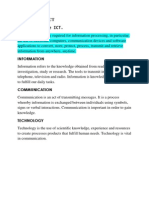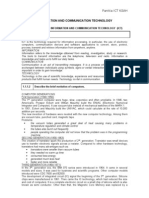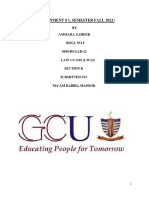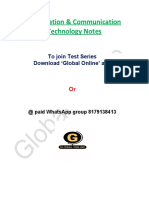Short Notes Ict
Short Notes Ict
Uploaded by
Noor SyafiqCopyright:
Available Formats
Short Notes Ict
Short Notes Ict
Uploaded by
Noor SyafiqCopyright
Available Formats
Share this document
Did you find this document useful?
Is this content inappropriate?
Copyright:
Available Formats
Short Notes Ict
Short Notes Ict
Uploaded by
Noor SyafiqCopyright:
Available Formats
1.1.1 Overview of (ICT) 1.1.1.1 Define ICT?
ICT is the technology required for information processing, in particular, the use of electronic computers, communication devices and software applications to convert, store, protect, process, transmit and retrieve information from anywhere, anytime. 1.1.1.2 Describe the brief evolution of computers Year 200 BC CHINESE ABACUS 500 BC EGYPTIAN ABACUS 1620 JOHN NAPIER NAPIER'S BONES 1653 BLAISE PASCAL PASCALINE 1801 JOSEPH MARIE JACQUARD 1823 CHARLES BABBAGE -MECHANICAL CALCULATOR MACHINE 1941 HARVARD UNIVERSITY-Mark 1 COMPUTER GENERATIONS FIRST GENERATION (1940-1956) The first generation of computer were huge, slow, expensive and often unreliable. In 1946, two Americans, Presper Eckert and Willian Mauchly build the ENIAC (Electronic Numerical Integrator and Computer). It use vacuum tube instead of mechanical switches of the MARK 1. In 1951, Eckert and Mauchly build the UNIVAC, which could calculate at the rate of 10,000 addition per seconds Hardware Technology New invention of hardware were needed with the new computer technology.
nology VACUUM TUBE The vacuum tube was an extremely important step of the advancement of computers.In a computer, a vacuum tube which is an electronic tube about the size of light bulbs, was used as the internal computer components. Thousands of them were used. Punched card was used to store data. Magnetic tape was introduced in 1957. It was a faster and a more compact method of storing data. Using magnetic tape became more reliable and costeffective.
The creation of transistor spark the production of a wave of second generation computer. Transistor was small devices use to transfer electronic signals across a resister. Transistors had many advantages compared to other hardware technology. transistors were smaller than vacuum tubes they needed no warm up time consumed less energy generated much less heat faster and more reliable
Silicone chips were reliable, compact and cheaper. Sold hardware and software separately which created the software industry. customer service industry flourished (reservation and credit checks)
FOURTH GENERATION (1971PRESENT) It took only 55 years for the 4 generations to evolve. The growth of the computer industry developed technologies of computer inventions. There are many types of computer models such as: Apple Macintosh IBM DELL ACER In 1971 Intel created the first microprocessor. In 1976, Steve Jobs built the first Apple computer. Then, in 1981, IBM introduced its first personal computer. During the fourth generation, hardware technology such as silicone chips, microprocessor and storage devices were invented. A microprocessor is a specialized chip which is developed for computer memory and logic. The microprocessor is a large-scale integrated circuit which contained thousands of transistors. The transistors on this one chip are capable of performing all of the functions of a computer's central processing unit. Advantages Computers became 100 times smaller than ENIAC (Electronic Numerical Integrator and Computer) the first computer Gain in speed, reliability and storage capacity
PUNCHED CARD MAGNETIC TAPE
THIRD GENERATION (19641971) In the third generation era, the IBM 370 series were introduced in 1964. It came in several models and sizes.It was used for business and scientific programs. Other computer models introduced were CDC 7600 and B2500. The development of integrated circuit (IC), signal the beginning of the third generation computers. Silicone chips were manufactured in 1961 at the Silicone Valley. Then came the integrated circuit technology, which had reduced the size and cost of computers. It is a complete electronic circuit on a small chip of silicone. Which is also known as semi conductor. Other than that, the Magnetic Core Memory was replaced by a device called the microchip. Also the first 256 bit RAM was introduced and it was the basis for development of 1K bit RAM. Advantages A new concept in this generation was that of a family of computer which allowed computer to be upgraded and expanded as necessary.
Problems the vacuum tubes generated a great deal of heat causing many problems in temperature regulation and climate control the tubes also burnt out frequently people operating the computer did not know that the problem was in the programming machine the second generation computer scientists invented something new due to lots of problem created by vacuum tubes
SECOND GENERATION (19561963) The famous computer scientists during the second generation era were:
Tech-
Details
Personal and industry boomed
software
FIFTH GENERATION (PRESENT & BEYOND) The fifth generation computers are technologically advance and are still being development to become more efficient. The inventions of new hardware technology in the fifth generation have grown rapidly including many other modern computer devices such as : silicone chips processor robotics virtual reality intelligent systems programs which translate languages NEW ERA COMPUTER After the fifth generation computer, the technology of computer has become more advanced, modern and sophisticated. The latest invention in the era of computers are : Super Computers Mainframe Computers Mini Computers Personal Computers Mobile Computers In the new era of computers, expert system such as teleconferencing and speech-recognition system have been invented as part of modern world communication tools. 1.1.2.1 ICT In Everyday Life: -Education -Banking -Industry -E-Commerce -Architecture -Arts -Career -Government -Healthcare -Home -Law Enforcement -Transportation -Travel 1.1.2. COMPUTERISED AND NONCOMPUTERISED SYSTEMS
EDUCATION education is the science of teaching and learning of specific skills it also imparts knowledge, good judgement and wisdom BANKING SYSTEM BANKING BEFORE ICT -banking was done manually by taking deposits directly -ransactions can only be made during working hours -takes time to approve any loan applications BANKING WITH ICT -all transactions are done by computers -transaction can be done at anytime and place -online services, phone banking system, credit cards are available INDUSTRY INDUSTRY BEFORE ICT Production was slow because everything was done manually and totally depended on human labour. INDUSTRY WITH ICT Computers and telecommunications industry became very opular and profitable since production can be increased through an all day operation. COMMERCE Commerce is an activity of exchanging, buying and selling of commodities on a large scale involving transportation from place to place. COMMERCE BEFORE ICT
-Trading was made using the barter system and it was then later developed into currency. -Advertisement was in the form of word of mouth, billboards and printed flyers. -Trading globally was extremely slow, late and expensive. Traders had to find ways to market local products in the global market. COMMERCE WITH ICT E-commerce plays an important role in the economic scene. It includes distribution, buying, selling and servicing products that are done electronically. 1.1.2.3 STATE THE IMPACT OF ICT ON SOCIETY -Faster Communication Speed -Lower Communication Cost -Reliable Mode Of Communication -Effective Sharing Of Information -Paperless Environment -Borderless Communication -Social Problems -Health Problems
-involvement in stealing software -invasion of privacy Intellectual property refers to any product of human intellect that is unique and has value in the market place. This covers ideas, inventions, unique name, computer program codes and many more. What Is Privacy? Privacy in IT refers to data and information privacy. Data refers to a collection of raw unprocessed facts, figures and symbols. Then, computer is used to process data into information. Information privacy is described as the rights of individuals and companies to deny or restrict the collection and use of information about them. What is Cyber Law? Cyber law refers to any laws relating to protecting the Internet and other online communication technologies. COMPUTER CRIMES A computer crime is defined as any criminal activity that is related to the use of computers. These activities include computer fraud, copyright infringement, computer theft and computer attack.
1.2 COMPUTER ETHICS AND LEGAL ISSUES Define Computer ethics Computer ethics is a system of moral standards or values used as a guideline for computer users. Codes Of Ethics Examples of ethical computer code of conducts include: -sending warning about viruses to other computer users -asking permission before sending any business advertisements to others -using information with authorization Examples of unethical computer code of conducts include: -modifying certain information on the Internet, affecting the accuracy of the information -selling information to other parties without the owners permission -using information without authorization
1.2.1.2 DIFFERENCES BETWEEN ETHICS AND LAWS ETHICS As a guideline to computer users. MORAL Ethical behaviour is STANDARDS judged by moral standards. FREE TO Computer users are FOLLOW free to follow or ignore the code of ethics. NO No punishment for PUNISHMENTS anyone who GUIDELINE
UNIVERSALS PRODUCE ETHICAL COMPUTER USERS IMMORAL
violates ethics. Universal, can be applied anywhere, all over the world. To produce ethical computer users. Not honouring computer ethics means ignoring the moral elements (immoral). LAW As a rule to control computer users. Law is judged by judicial standards. Computer users must follow the regulations and law. Penalties, imprisonments and other punishments for those who break the law. Depends on country and state where the crime is committed. To prevent misuse of computers. Not honouring the law means committing a crime.
Security Services to review the security policy Security Management to protect the resources Security Mechanism to implement the required security services Security Objects, the important entities within the system environment
(b) Utilities software Example: anti-spam program, firewall, anti-spyware and antivirus. 1.2.2.2 State Authentication And Verification Methods/Technology METHODS OF AUTHENTICATION There are two commonly used authentication methods, which are biometric device and callback system. Biometric device is a device that translates personal characteristics into a digital code that is compared with a digital code stored in the database. Examples: Fingerprint Recognition Facial Recognition Hand Geometry Scanning Iris Scanning Retinal Scanning Voice Recognition Signature Verification System Callback system refers to the checking system that authenticates the user. METHODS OF VERIFICATION There are two methods commonly used in verification, which are user identification and processed object. User identification refers to process of validating the user. the
Pornography can lead to criminal acts such as exploitation of women and children can lead to sexual addiction or perversion can develop low moral value towards other men, women or children can erode good religious, cultural and social beliefs and behaviour Slander can develop into a society that disregards honesty and truth can develop bad habit of spreading untruths and rumours can lead to unnecessary argument can cause people to have negative attitudes towards another person 1.2.3.2 Describe the process of filtering to control access to controversial contents. The current preferred method of choice to limit access on the Internet is to filter content either by: keyword blocking site blocking web rating systems KEYWORD BLOCKING One of the strategies is by using the keyword blocking method.This method uses a list of banned words or objectionable terms. As the page is downloading, the filter searches for any of these words. If found, it will block the page completely, stop downloading the page, block the banned words and even shut down the browser. SITE BLOCKING software company maintains a list of dubious Internet sites
the software prevents access to any sites on this list denial lists regularly updated some software provides control over what categories of information you block Who decides what goes on the denial list and what criteria are they using? can you keep track of the whole of the Internet? filters can use both site blocking and word blocking
CONTROL JUDICIAL STANDARDS MUST FOLLOW PENALTIES, IMPRISONME NTS AND OTHER PUNISHMENT S DEPENDS ON COUNTRY
WEB RATING SYSTEMS Web sites are rated in terms of nudity, sex, violence and language. The Recreational Software Advisory Council (RSACI) is responsible for the rating of the websites on the content on the internet. ratings done either by the web page author or by the independent bureau. browsers set to only accept pages with certain levels of ratings.
PREVENT MISUSING OF COMPUTERS CRIME
1.2.4 Computer Crimes 1.2.4.1 Explain the need for Cyber Law.
1.2.1.3 Satate the need for Intellectual Property Law Intellectual Property laws cover ideas, inventions, literary creations, unique names, business models, industrial processes, computer program codes and more. 1.2.2 Privacy 1.2.2.1 List ways to protect privacy (a) Privacy law The privacy laws in Malaysia emphasises on the following:
Processed object refers to something the user has such as identification card, security token and cell phone. 1.2.3 CONTROVERSIAL CONTENT AND CONTROL 1.2.3.1 List effects of Controversial Content On Society
In te g Secu
1.2.4.2 Explain briefly the computer crimes below: Fraud ,Copyright Infringement, Theft , Attacks COMPUTER FRAUD Computer fraud is defined as having an intention to take advantage over or causing loss to other people, mainly on monetary basis through the use of computers. There are many forms of computer fraud which include e-mail hoaxes, programme fraud, investment schemes, sales promotions and claims of expertise on certain fields. Students need to be aware of other computer frauds such as health frauds, scams and hacking. Students will also most likely get false information while researching information on the Internet. COPYRIGHT INFRINGEMENT Copyright infringement is defined as a violation of the rights secured by a copyright. Copyright infringement involves illegal copy or reproduction of copyrights material by the black market group. The open commercial sale of pirated item is also illegal. With the current technology, the most perfect copy of the original copy can be downloaded from the internet. COMPUTER THEFT Computer theft is defined as the unauthorised use of another persons property with the intention to deny the owner the rightful possession of that property or its use. Examples of computer theft include: -transfer of payments to the wrong accounts -tap into data transmission lines on database at no cost -divert goods to the wrong destination COMPUTER ATTACK Computer attack may be defined as any activities taken to disrupt the equipment of computer systems,
change processing control or corrupt stored data. Computer attack can be in the forms of: -physical attack that disrupt the computer facility or its transmission lines. -an electronic attack that uses the power of electromagnetic energy to overload computer circuitry. -a computer network attack that uses -a malicious code to exploit a weakness in software, or in the computer security practices of a computer user 1.3.1.1 Define computer security. Computer security means protecting our computer systems and the information they contain against unwanted access, damage, destruction or modification. 1.3.2 Security Threats 1.3.2.1 Explain briefly the different threats to computer security: MALICIOUS CODE Malicious code is also known as a rogue program. It is a threat to computing assets by causing undesired effects in the programmers part. The effect is caused by an agent, with the intention to cause damage. The agent for malicious code is the writer of the code, or any person who causes its distribution. There are various kinds of malicious code. They include virus, Trojan horse, logic door, trapdoor and backdoor, worm and many others. a) VIRUS b) TROJAN HORSE c) LOGIC BOMB d) TRAPDOOR OR BACKDOOR e) WORM HACKING Hacking is a source of threat to security in computer. It is defined as
unauthorised access to the computer system by a hacker. Hackers are persons who learn about the computer system in detail. They write program referred to as hacks. Hackers may use a modem or cable to hack the targeted computers. NATURAL AND ENVIRONMENTAL THREATS Computers are also threatened by natural or environmental disaster. Be it at home, stores, offices and also automobiles.Examples of natural and environmental disasters: Flood Fire Earthquakes, storms and tornados Excessive Heat Inadequate Power Supply THEFT Two types of computer theft: 1) Computer is used to steal money, goods, information and resources. 2) Stealing of computer, especially notebook and PDAs. Three approaches to prevent theft: 1) prevent access by using locks, smart-card or password 2) prevent portability by restricting the hardware from being moved 3) detect and guard all exits and record any hardware transported 1.3.3 Security Measures 1.3.3.1Select the appropriate security measures to overcome the identified computer threats Security measures mean the precautionary measures taken toward possible danger or damage. There are 6 type of security measures.
1.3.3.2 Apply the correct security procedures. a) ANTIVIRUS An antivirus program protects a computer against viruses by identifying and removing any computer viruses found in the computer memory, on storage media or incoming e-mail files. An antivirus program scans for programs that attempt to modify the boot program, the operating system and other programs that normally are read from but not modified.
b)ANTI-SPYWARE Spyware is a program placed on a computer without the users knowledge. It secretly collects information about the user. The spyware program communicates information to the outside source. An anti-spyware application program sometime called tracking software or a spybot is used to remove spyware. Among of the popular anti-spyware programs are: Spybot Search and Destroy Ad-aware Spyware Blaster c)CRYPTOGRAPHY Cryptography is a process of hiding information by altering the actual information into different representation, for example, an APA can be written as I? X.
Almost all cryptosystems depend on a key such as a password like the numbers or a phrase that can be used to encrypt or decrypt a message. The traditional type of cryptosystem used on a computer network is called a symmetric secret key system. d) FIREWALL Firewall is a piece of hardware or software which functions in a networked environment to prevent some communications forbidden by the security policy. Firewall implement a security policy. It might permit limited access from in or outside the network perimeters or from certain user or for certain activities. e)DATA BACKUP Data Backup is a program of file duplication. Backups of data applications are necessary so that they can be recovered in case of an emergency. Depending on the importance of the information, daily, weekly or biweekly backups from a hard disk can be performed. f)HUMAN ASPECTS Human aspects refer to the user and also the intruder of a computer system. It is one of the hardest aspects to give protection to. The most common problem is the lack of achieving a good information security procedure. 1.4.1 Impact of ICT on Society HOME AND EDUCATION COMPUTERS FOR HIGHER EDUCATION BUSINESS COMPUTERS IN BANKING INDUSTRY GRAPHICS AND MULTIMEDIA
COMMUNICATION COMPUTERS IN TOURISM COMPUTERS IN THE HEALTHCARE SCIENCE
You might also like
- AWR138WDocument32 pagesAWR138WJoseNo ratings yet
- Honeywell DVM R700 Network and Security Planning Guide v3Document187 pagesHoneywell DVM R700 Network and Security Planning Guide v3cristhian alfonsoNo ratings yet
- 1.1.1.1 Define ICTDocument6 pages1.1.1.1 Define ICTBIawak DophNo ratings yet
- NaniDocument15 pagesNaniNani Nanie IINo ratings yet
- Panitia Ict KsahDocument8 pagesPanitia Ict KsahSyahirah IsmailNo ratings yet
- History of ComputersDocument32 pagesHistory of Computerssophia_adelle100% (1)
- ICT ReviewerDocument5 pagesICT Reviewerchristian b. dellotaNo ratings yet
- Introduction To ICTDocument41 pagesIntroduction To ICTmeekyongcastro99No ratings yet
- History of ICTDocument24 pagesHistory of ICTJoannaylish Padillo PerozNo ratings yet
- Notes Ict MasterDocument49 pagesNotes Ict MasterHZ_93100% (2)
- Unit I DigitalDocument29 pagesUnit I Digitalishmanikour04No ratings yet
- Teknologi Maklumat Dan KomunikasiDocument23 pagesTeknologi Maklumat Dan KomunikasisuhanitaNo ratings yet
- CD 1form4Document39 pagesCD 1form4Qiraz ZivNo ratings yet
- First Generation: Vacuum Tubes. Mid 1940s. IBM Pioneered The Arrang3ment of VacuumDocument12 pagesFirst Generation: Vacuum Tubes. Mid 1940s. IBM Pioneered The Arrang3ment of VacuumwinyeeNo ratings yet
- Assigment Evolution of ComputerDocument8 pagesAssigment Evolution of ComputerM Luqman SarwarNo ratings yet
- Mr. Jayesh Gangadhar Shinde: Information and Communication TechnologyDocument141 pagesMr. Jayesh Gangadhar Shinde: Information and Communication Technologyshinde_jayesh2005No ratings yet
- Computer Course DPTDocument39 pagesComputer Course DPTmishal zikriaNo ratings yet
- Submitted By:: Comsats University Islamabad Sahiwal CampusDocument9 pagesSubmitted By:: Comsats University Islamabad Sahiwal Campushamza iqbalNo ratings yet
- Abdul Shakoor Br540076Document27 pagesAbdul Shakoor Br540076Abdul ShakoorNo ratings yet
- It Fundamentals Module (Prelim Midterm) 1Document32 pagesIt Fundamentals Module (Prelim Midterm) 1Jamaica GarciaNo ratings yet
- Chapter #1 Introduction and History of ComputerDocument9 pagesChapter #1 Introduction and History of Computersyed abu hurairaNo ratings yet
- Introduction and History of Computers 2022-2023 Session-1Document16 pagesIntroduction and History of Computers 2022-2023 Session-1edith Azakaye IzekorNo ratings yet
- Copyofcomputerfinalppt 130903070322Document25 pagesCopyofcomputerfinalppt 130903070322Jonalyn MananganNo ratings yet
- Assignment 1. Living in The IT EraDocument17 pagesAssignment 1. Living in The IT EraTamayo HelbertNo ratings yet
- Introduction To Computers (2) - 001Document32 pagesIntroduction To Computers (2) - 001michael luganoNo ratings yet
- Com111 1Document38 pagesCom111 1Jamiu Muibudeen JamtechNo ratings yet
- Group 1: Introduction To ComputersDocument29 pagesGroup 1: Introduction To ComputersJennylyn BoiserNo ratings yet
- Introduction To ComputersDocument13 pagesIntroduction To Computersqbilal.1303No ratings yet
- Intro To CompDocument12 pagesIntro To Compraghushetty49No ratings yet
- Module For Chapter 1Document17 pagesModule For Chapter 1cristine de mesaNo ratings yet
- Em Tech First Sem NotesDocument7 pagesEm Tech First Sem NotesGoodweb ShitNo ratings yet
- Computer AssignmentDocument7 pagesComputer AssignmentAmaraNo ratings yet
- IIT. TCC1 VKDocument160 pagesIIT. TCC1 VKAmar Ali JunejoNo ratings yet
- Chapter 01 Our Digital PlanetDocument23 pagesChapter 01 Our Digital PlanetNoof AlkitbiNo ratings yet
- Cit 100Document132 pagesCit 100Visitantuly PilysonNo ratings yet
- CSC 101Document45 pagesCSC 101Bridget JamesNo ratings yet
- Lesson 1 ICTDocument30 pagesLesson 1 ICTAnonymous AccountNo ratings yet
- Pad 116Document34 pagesPad 116Michael T. BelloNo ratings yet
- Communication TechnologyDocument5 pagesCommunication TechnologyHerthik PrathabanNo ratings yet
- History of Information Technology: by Julia OlkhovykDocument24 pagesHistory of Information Technology: by Julia OlkhovykЮлія ОльховикNo ratings yet
- BCS101 - Focp PDFDocument125 pagesBCS101 - Focp PDFsania2011No ratings yet
- Revier Grade 7Document4 pagesRevier Grade 7buitrechristeoffcyrusNo ratings yet
- It App Tools in Business: Data Processing SystemsDocument8 pagesIt App Tools in Business: Data Processing SystemsPanes GrenadeNo ratings yet
- GST 313 Introduction To Computer NoteDocument42 pagesGST 313 Introduction To Computer Notenyg8gkrbfbNo ratings yet
- Lec 1Document15 pagesLec 1smnepalschoolNo ratings yet
- Wa0006.Document17 pagesWa0006.SHASHI SHEKHAR SinghNo ratings yet
- Module 2 History of IctDocument40 pagesModule 2 History of Ictnaomiakor0No ratings yet
- UNIT-1 Fundamentals of Information Technology (Question and Answers)Document13 pagesUNIT-1 Fundamentals of Information Technology (Question and Answers)Dr. S.K. SajanNo ratings yet
- Introduction To Ict - 2023Document30 pagesIntroduction To Ict - 2023usmantukurNo ratings yet
- Computer Generations Daniela MataDocument10 pagesComputer Generations Daniela MataDaniela MataNo ratings yet
- Lecture Note For ND1 Computer ScienceDocument34 pagesLecture Note For ND1 Computer Sciencepaulbak236No ratings yet
- Resentation ON Omputer EnerationDocument25 pagesResentation ON Omputer EnerationnarayanNo ratings yet
- ICT English NotesDocument49 pagesICT English NotesAnkita DasNo ratings yet
- Information TechnologyDocument29 pagesInformation Technologysanchiga nandhiniNo ratings yet
- Chapter1 Pt2 - NewDocument41 pagesChapter1 Pt2 - NewMuhammadAsifNo ratings yet
- Mpco Pra-1Document5 pagesMpco Pra-1Drive UserNo ratings yet
- CSC NoteDocument42 pagesCSC NoteRaji AndrewNo ratings yet
- Basics of ComputerDocument9 pagesBasics of Computerammarqazi53No ratings yet
- Programming Logic and Design Chapter-1Document26 pagesProgramming Logic and Design Chapter-1alfredcodingnowNo ratings yet
- Programming in C-1Document69 pagesProgramming in C-1iambinodbistNo ratings yet
- Classification - Types of ComputersDocument36 pagesClassification - Types of ComputersBudigoy IbarraNo ratings yet
- Gafunk PricelistDocument2 pagesGafunk Pricelisthifa55No ratings yet
- SMG Administration GuideDocument913 pagesSMG Administration GuideNguyễn Đình ThànhNo ratings yet
- GnuCOBOL 3.1.2 MinGW Build Guide V1.3Document34 pagesGnuCOBOL 3.1.2 MinGW Build Guide V1.3jalvarez82No ratings yet
- EUC1501 Assignment 01 (Compulsory) - Attempt RevieDocument39 pagesEUC1501 Assignment 01 (Compulsory) - Attempt RevieSindyNo ratings yet
- Epas Curriculum GuideDocument58 pagesEpas Curriculum GuideCharlie ArguellesNo ratings yet
- CISA Simulation-3Document20 pagesCISA Simulation-3shehzaib tariqNo ratings yet
- The Curious Case of Machine Learning in Malware Detection: Sherif Saad, William Briguglio and Haytham ElmiligiDocument9 pagesThe Curious Case of Machine Learning in Malware Detection: Sherif Saad, William Briguglio and Haytham ElmiligiTuan Anh NguyenNo ratings yet
- Malwarebytes KeyDocument1 pageMalwarebytes KeyEzlan HarithNo ratings yet
- Cylance PROTECTDocument2 pagesCylance PROTECTNikesh dubeyNo ratings yet
- Unofficial PokeOne Installation Guide PDFDocument5 pagesUnofficial PokeOne Installation Guide PDFTony Markuschvsky PinheiroNo ratings yet
- Testing Antivirus Scanning ExceptionsDocument3 pagesTesting Antivirus Scanning ExceptionsHarboot MachiatoNo ratings yet
- Fortiweb v6.2.0 Release NotesDocument22 pagesFortiweb v6.2.0 Release NotesCarlosNo ratings yet
- Softmart EndUser PricelistDocument46 pagesSoftmart EndUser PricelisttmangatNo ratings yet
- History of PC VirusDocument4 pagesHistory of PC VirusKhanjanNo ratings yet
- 210-250 Dump Ans by Lead 2 PassDocument22 pages210-250 Dump Ans by Lead 2 Passrita100% (1)
- Computer in Our Daily LifeDocument7 pagesComputer in Our Daily LifeFranny Be AminoNo ratings yet
- Como Instalar Assassins Creed Black Fag, Far Cry 4 V1.7 y V1.9Document3 pagesComo Instalar Assassins Creed Black Fag, Far Cry 4 V1.7 y V1.9Doris Aguilar UlacioNo ratings yet
- CIS Controls Measures and Metrics V7Document55 pagesCIS Controls Measures and Metrics V7damola2realNo ratings yet
- CQI-IRCA LA Online Exam Guide5Document8 pagesCQI-IRCA LA Online Exam Guide5shams aliNo ratings yet
- Procedure 1610 PR.01 Systems and Network Security: Revision Date: 6/10/11Document5 pagesProcedure 1610 PR.01 Systems and Network Security: Revision Date: 6/10/11Alok SinghNo ratings yet
- Installation and Administration Guide SEP14Document814 pagesInstallation and Administration Guide SEP14Désiré Ngaryadji100% (1)
- M-S1104 Firewall Enterprise Sidewinder Setup GuideDocument744 pagesM-S1104 Firewall Enterprise Sidewinder Setup GuideDonald LuceroNo ratings yet
- SASE Architecture: Architecture Reference Guide For The Implementation of Secure Access Service EdgeDocument35 pagesSASE Architecture: Architecture Reference Guide For The Implementation of Secure Access Service EdgemanishNo ratings yet
- Class NotesDocument5 pagesClass NotesJoshua CrescendoNo ratings yet
- EcoStruxure™ PowerMonitoringExpert System Guide 2022Document1,952 pagesEcoStruxure™ PowerMonitoringExpert System Guide 2022jamesNo ratings yet
- Security Best Practice - Hardening GuideDocument12 pagesSecurity Best Practice - Hardening Guidemanvi 16No ratings yet
- Sas Installation GuideDocument30 pagesSas Installation Guideabdul rasheed shaikNo ratings yet
- AMIT 1703 IT Fundamentals and Application Tutorial 6 AnswersDocument3 pagesAMIT 1703 IT Fundamentals and Application Tutorial 6 AnswersWilliamLokNo ratings yet



